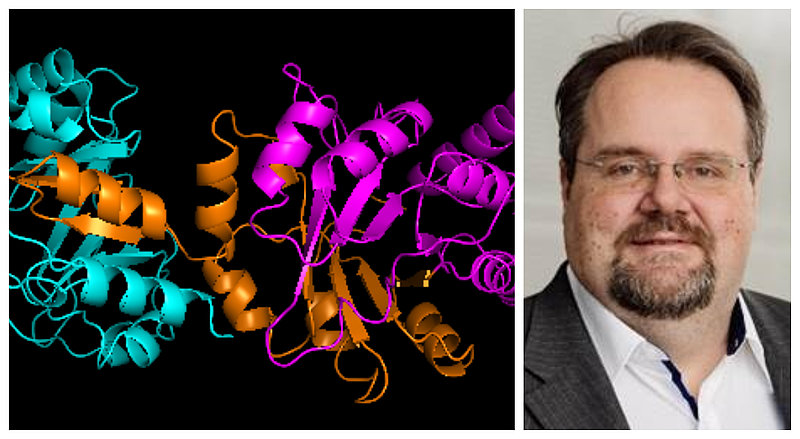- Mr Schwaneberg, in our MIX-UP project enzymes are the big player, without them nothing would work. Many people have heard about them. But many people don't realise how diverse enzymes are. Where do we encounter them?
Well, I bet you have come into contact with enzymes at least once before our interview today: When you brush your teeth, when you do your laundry, when you eat bread, when you fill up with bioethanol - there are enzymes in all of them. For us humans and in the metabolism of living organisms, they are often essential for survival.
- So - provocatively asked - they are not small, useless molecules that just happen to exist in nature?
Not at all! (laughs) Without them, our everyday life would hardly function as we would like it to. They are crucial for the properties of products, materials or even active substances. In this way, they contribute to the well-being of society. The benefits to society are so huge that there was even a Nobel Prize in 2018 for what is known as "Articulated Evolution", which refers to the process by which enzymes are tailored to create benefits for humans. Think of bioethanol, mentioned earlier, a bulk product where customised enzymes and organisms make low-cost production conditions possible in the first place. In the late 1980s, when enzymes could not yet be customised, complex and technically sophisticated bioprocesses were developed to deal with insufficient enzyme properties such as temperature or process stability. The result: the bioprocesses were of course correspondingly expensive.
- But let's take another step back. When I think of "jointed evolution" from a biological point of view, numerous terms come to mind; amino acids, proteins, bacteria - so what exactly are enzymes?
Very roughly speaking, enzymes are molecular machines that are a few nanometres in size and accelerate chemical reactions. For example, enzymes in detergents are used to remove dirt in combination with other components that make our everyday lives easier. And if you connect many enzymes in series, you can produce very complex products with very simple methods in whole organisms or in enzyme cascades that enrich our everyday lives.
- At first glance, however, your research doesn't have much to do with everyday life, but high-tech - it's not about the small things in everyday life, but the big picture. How does this highly specialised research contribute first of all to a bioeconomy and overall to a better world?
We can do more with less with customised enzymes. We have developed methods to generate diversity and produce customised enzymes for each application; several million variants can be generated in a few hours and screened in days to find enzyme variants that are then faster, more active, and or more stable. That's why many companies come to us and have their catalysts customised - for example Henkel in the HICAST (Henkel Innovation Campus for Advanced and Sustainable Technologies) project, where we optimised detergent enzymes so that they work efficiently at lower temperatures. This saves a lot of energy when washing and is ultimately more sustainable. That may sound trivial on the one hand, but if you think about the fact that our body fat only becomes liquid so slowly at 35 to 37 degrees and you want to wash at 30 degrees, the enzymes have to nibble their way through a "solid", so to speak.
- - So in a certain sense you and your colleagues are designers?
That certainly sounds better than protein engineering. (laughs)
- - ... and one of your papers is also about designing enzymes to be thermostable. What are the advantages of that?
If enzymes are more thermostable, they often also have higher storage and process stability. However, enzymes become rigid with higher thermostability; but for high activity, you need high flexibility. To change this in such a way that it serves product requirements including storage and process stability is often a great challenge or a supreme discipline in enzyme design.
- ... and according to one of your papers, this is also applied in the food industry by optimising plants?
Not directly the plants, but we decorate gels of our colleague Mr. Pich with proteins that bind to the wax layer of leaves and successfully complete the first field trials. The gels serve as a "container" in which we pack all kinds of active substances to release them slowly and selectively after leaf binding. The rainfastness of the binding ensures that more healthy food can be produced with less pesticide. There are no limits to the application areas of such adhesion promoters, be it gels or other means to transport the active ingredients, for example medical technology to apply coatings to implants to prevent inflammation.
- Much of this still happens in the laboratory and on a small scale. Will this biotechnology be standard in ten years?
From my point of view, an unequivocal yes! Look at what progress has been made with RNA technologies for vaccines and the Nobel Prizes for Articulated Evolution and CRIPR CAS show the high societal benefit that biotechnology can bring to society and a sustainable circular economy.
- Thank you very much for the interview, Mr Schwaneberg!


